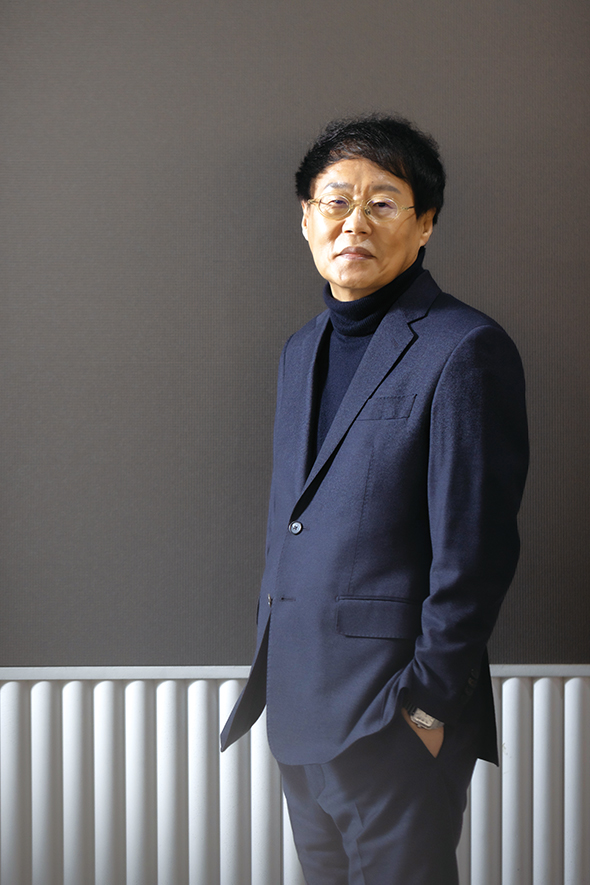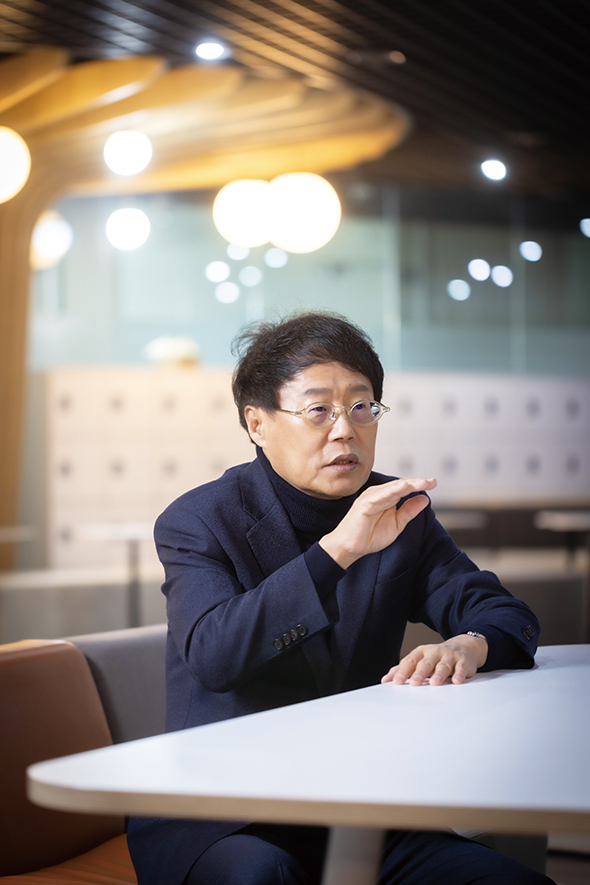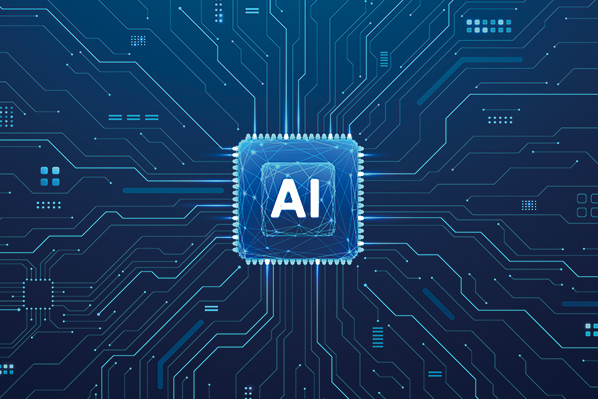

Story
‘어게인 K-반도체’
열정과 성공의 DNA 이어 나가야
“Again, K-Semiconductors”
The DNA of Passion and Success Must Be Continued
융합전자공학부 박재근 석학교수
(첨단반도체소재/소자개발연구소, 차세대메모리산학연공동연구센터)
Jea-Gun Park, Emeritus Professor of Education at the School of Electronic Engineering
(Advanced Semiconductor Materials/Device Development Center, Industry/University Cooperative Research Center for Next-Generation Memory Development)
- 글 박영임
- 사진 손초원
- Writing Park Young-im
- Photograph Son Cho-won
Scroll Down
Concerns are growing that Korea's semiconductor industry could face a crisis amid the rapidly changing global semiconductor industry ecosystem. We met with Professor Jea-Gun Park, an expert in semiconductor materials and devices who developed defect-free silicon wafer technology and localized chemical-mechanical planarization (CMP) slurry during his tenure at Samsung Electronics, earning him the Order of Science and Technology Merit Doyak Medal, to hear his suggestions for the development of the domestic semiconductor industry.

반도체는 경제 발전의 원동력
“1980년대 초 컴퓨터가 일반인에게 보급되면서 PC에 들어가는 CPU와 D램이 제1차 반도체 성장 파도를 불러왔습니다. 그러다 성장이 둔화할 즈음 애플의 아이폰 출시로 스마트폰이 확산돼 무선 인터넷 시대가 열리면서 제2차 반도체 성장 파도가 일었죠. 그리고 2022년 오픈AI의 챗GPT로부터 급부상한 생성형 AI에 의해 제3차 반도체 성장 파도가 시작됐습니다.”
박재근 교수의 설명에 의하면 제3차 반도체 성장 파도는 이미 집채만 한 파고로 밀려오고 있다. 제1, 2차 반도체 성장 파도를 촉발한 PC와 스마트폰은 산업의 패러다임뿐 아니라 일반인들의 일상을 완전히 바꿔놓은 제품들이다. 그런데 생성형 AI가 불러올 혁신이 그에 맞먹는다고 보는 것이다. 특히 AI를 구동하려면 AI 가속기라는 하드웨어가 필요한데 그 안에 들어가는 GPU와 고대역폭 메모리(HBM)가 반도체 산업의 새로운 성장을 이끌고 있다. 이렇게 세상을 바꾼 혁신 제품 PC, 스마트폰, 생성형 AI의 탄생은 모두 반도체의 발전이 있었기에 가능한 것이었다. 그렇기에 반도체는 ‘산업의 쌀’이라고도 불린다.
“현재 우리의 일상생활은 반도체 없이는 영위할 수 없습니다. 스마트폰에만 해도 40개가 넘는 반도체 칩이 들어갑니다. 특히 제4차 산업혁명 바람이 불면서 AI, IoT, 메타버스, 로봇 등이 부상했는데 그들의 하드웨어는 전부 반도체로 움직입니다. 만약 기업에서 반도체를 확보하지 못하면 사업을 이어갈 수 없다는 얘기죠. 그래서 주요 국가들은 반도체 기술력 없이는 미래도 없다는 위기의식을 가지고, 전폭적으로 반도체 산업을 지원하고 있습니다.”
이것이 글로벌 시장에서 국운을 건 반도체 기술 패권 경쟁이 치열하게 벌어지는 이유다. 미국 정부는 경제 및 국가 안보를 위해 2022년 반도체지원법(CHIPS Act)을 제정한 후 반도체 제조 시설, 장비 투자 등을 위한 인센티브 프로그램을 시행해 왔다. EU도 반도체법을 제정해 보조금 지급, 세제 혜택 등을 제공하고 있다. 중국은 이미 2015년 1390억 위안(한화 24조 원) 투자를 시작으로 2025년까지 1조 위안(한화 170조 원)을 투자해 반도체 자급률을 70%로 끌어올린다는 계획을 실행 중이다. 일본 역시 반도체 산업을 다시 일으키기 위해 투자를 확대하고 있다.
Semiconductors: The Driving Force of Economic Development
“As computers became widely available to the general public in the early 1980s, the CPU and DRAM used in PCs triggered the first wave of semiconductor growth. Just as that growth began to slow down, the launch of Apple's iPhone led to the proliferation of smartphones and the dawn of the wireless internet era, triggering the second wave of semiconductor growth. And in 2022, the rapid rise of generative AI, sparked by OpenAI's ChatGPT, initiated the third wave of semiconductor growth.”
According to Professor Jea-Gun Park, the third wave of semiconductor growth is already approaching with enormous waves. PCs and smartphones, which triggered the first and second waves of semiconductor growth, are products that have completely transformed not only the industry paradigm but also the daily lives of ordinary people. The point is that the innovation that generative AI will bring is considered to be comparable to that. In particular, running AI requires hardware called AI accelerators, and the High Bandwidth Memory (HBM) of GPUs used in these devices is driving new growth in the semiconductor industry. The birth of innovative products that changed the world, such as PCs, smartphones, and generative AI, was all possible thanks to the advancement of semiconductors. Hence, semiconductors are also called the “backbone of industries.”
“Our daily lives cannot be maintained without semiconductors. A smartphone alone contains more than 40 semiconductor chips. Particularly, as the Fourth Industrial Revolution trend emerges, technologies like AI, IoT, metaverse, and robots are rising, and their hardware all operates on semiconductors. This means that if companies cannot secure semiconductors, they cannot continue their business. Therefore, major nations, with the awareness that there is no future without semiconductor technology, are providing full support to their own semiconductor industry.”
This is why there is fierce competition for technological hegemony in semiconductors, with national destiny at stake in the global market. The US government has implemented incentive programs for semiconductor manufacturing facilities and equipment investment after enacting the CHIPS Act in 2022 for economic and national security. The EU has also enacted the Chips Act to provide subsidies, tax benefits, and other incentives. China is already implementing a plan that began with an investment of 139 billion yuan (24 trillion KRW) in 2015 and aims to invest 1 trillion yuan (170 trillion KRW) by 2025 to raise semiconductor self-sufficiency to 70%. Japan is also expanding investments to revitalize its semiconductor industry.



경제 및 국가 안보를 위해 국가 주도산업으로 부상
세계적인 반도체 강국인 우리나라에서 반도체는 수출 효자 품목이다. 산업통상자원부 발표에 따르면 2024년 우리나라 전체 수출액에서 반도체가 차지하는 비중은 20.8%인 것으로 나타났다. AI 열풍으로 고부가가치 제품인 HBM과 DDR5 수출 비중도 확대되고 있다. 글로벌 반도체 시장에서 차지하는 점유율도 높다. 유진투자증권의 자료에 의하면, 2023년 12월 기준으로 한국의 글로벌 반도체 시장 매출 점유율은 2위, 생산 점유율은 1위를 차지했다. 하지만 박재근 교수는 위기의식을 가져야 한다며 낯빛이 어두워졌다.
“과거 PC와 스마트폰 시대에 우리나라는 고가의 메모리 반도체에 치중해 독과점적 시장 지위를 누려왔습니다. 그런데 미국의 마이크론이 우리나라와 동등한 수준의 기술력을 보이고, 새로운 경쟁자인 중국 업체들이 정부의 전폭적인 지원을 받아 빠르게 추격해 오고 있습니다. 한편, 비메모리 반도체 부문에서는 대만의 TSMC와 격차가 더욱 벌어지고 있는 실정입니다.”
우리나라 반도체 시장에 적색등이 켜진 것이다. 이에 국내 반도체 산업의 위기론이 불거지고 있다. 박재근 교수는 작금의 반도체 산업 위기론에 100% 동의한다며 가장 큰 문제는 반도체 산업이 국가가 나서서 육성하는 전략산업으로 변모했음에도 우리 정부는 안이한 태도를 보이고 있는 점이라고 강도 높게 지적했다.
“각 국가가 반도체 기술력 확보를 위해 반도체지원법을 제정해 적극적으로 지원하는데 반해, 우리는 반도체 산업 육성을 위한 반도체특별법뿐 아니라 반도체 산업에 우선적으로 전력을 공급한다는 내용을 담은 전력망확충특별법도 신속히 처리하지 못하고 있습니다. 반도체 산업은 타이밍이 중요하기 때문에 하루속히 반도체법을 발효해야 합니다.”
Emerging as a State-led Industry for Economic and National Security
In Korea, a global semiconductor powerhouse, semiconductors are a key export item that drives the nation’s economic growth. According to the Ministry of Trade, Industry and Energy's announcement, semiconductors account for 20.8% of our country's total export value in 2024. Due to the global AI boom, the export share of highvalue-added products such as HBM and DDR5 is also increasing. The market share in the global semiconductor market is also high. According to Eugene Investment & Securities' data, as of December 2023, Korea ranked second in global semiconductor market revenue share and first in production share. However, Professor Jea-Gun Park's expression darkened as he emphasized the need for a sense of crisis.
“In the past era of PCs and smartphones, our country has enjoyed an oligopolistic market position by focusing on high-end memory semiconductors. However, Micron from the United States is showing technological capabilities equal to our country, and new competitors from China are rapidly catching up with full government support. Meanwhile, in the non-memory semiconductor sector, the gap with Taiwan's TSMC is widening even further.”
A red light has been turned on in Korea's semiconductor market. As a result, concerns about a crisis in the domestic semiconductor industry are emerging. Professor JeaGun Park strongly pointed out that he 100% agrees with the current semiconductor industry crisis theory, and the biggest problem is that although the semiconductor industry has transformed into a strategic industry that the state should foster, our government is showing a complacent attitude.
“While other countries are actively supporting their semiconductor industries by enacting the CHIPS Act to secure semiconductor technology capabilities, we are failing to promptly process not only the Special Law on Semiconductors for fostering the semiconductor industry but also the Special Law on Power Grid Expansion, which includes provisions for prioritizing power supply to the semiconductor industry. Since timing is crucial in the semiconductor industry, the semiconductor law must be enacted as soon as possible.”

우리나라 반도체 시장에 적색등이 켜졌다. 정부의 적극적인 지원을 바탕으로 메모리 반도체 분야 경쟁자를 따돌리고, 비메모리 반도체 부문 기술력을 높여야 한다
A red light has been turned on in Korea's semiconductor market. Based on the government's active support, we must outperform competitors in the memory semiconductor sector and enhance technological capabilities in the non-memory semiconductor sector.
AI 반도체 리더십 놓쳐서는 안 돼
학계와 산업계를 대표하는 한국반도체디스플레이기술학회의 회장직을 맡고 있는 박재근 교수는 학회장으로서 업계의 의견을 모아 정부에 적극적인 지원을 촉구해 왔다. 이와 더불어 우수한 기술은 결국 우수한 인재로부터 창출되기에 정부에 우수 인재 양성 프로그램을 제안하고 있다. 우수한 인재를 더 많이 확보하기 위해 박재근 교수는 이제 과감한 정책을 펼쳐야 할 때라고 덧붙였다.
“미국이나 일본은 우수한 해외 유학생들이 자국에 정착할 수 있도록 지원책을 펼치고 있습니다. 우리나라도 해외 인재를 적극 포용하는 정책을 도입해야 합니다. 물론 기업 문화도 이들을 수용할 수 있도록 바뀌어야겠죠. 그리고 R&D 인력에 한해서는 미국이나 일본처럼 주 52시간 근무 예외 조항(White Collar Exemption)을 둬야 합니다. 연구개발은 시간과의 싸움입니다.”
첨단반도체소재/소자개발연구소와 차세대메모리산학연공동연구센터를 이끄는 박재근 교수 또한 AI 반도체 시대를 선도하기 위해 연구개발에 매진하고 있다. 박재근 교수는 반도체의 7대 공정 중 하나인 CMP(Chemical-Mechanical Planarization, 화학적 기계 연마) 공정에 사용되는 나노 소재를 개발하고, 반도체 스케일링다운(Scaling Down, 미세화) 기술인 CMP 슬러리 기술을 개발해 반도체 소부장(소재·부품·장비) 기업에 기술이전하고 있다. 반도체 기업들과 활발한 협업을 통해 AI 반도체의 리더십을 확보해야 한다고 강조하는 박재근 교수가 한양인들을 위해서도 당부의 말을 전했다.
“한양대는 우리나라가 반도체 산업을 육성하던 초기부터 우수한 인력을 기업체에 공급해 왔습니다. 그래서 많은 졸업생이 국내 굴지의 반도체 기업에서 활약하고 있습니다. AI 반도체 시대에도 자신의 역량을 마음껏 펼칠 수 있도록 자신감을 갖길 바랍니다. 이를 위해 재학 시절에 원 없이 열정을 쏟고 성공 경험을 쌓으며, 열정과 성공의 DNA를 계승해야 합니다.”
이것이 선두 주자만 살아남는 반도체 산업에서 K-반도체의 미래를 짊어질 인재들에게 박재근 교수가 간절히 바라는 것이다.
Timing Is Crucial to Secure Leadership in AI Semiconductors
Professor Jea-Gun Park, who serves as the president of the Korean Society of Semiconductor & Display Technology representing both Korean academic and industrial sectors, has been actively urging the government for support by gathering industry opinions in his capacity as the society's president. Furthermore, since excellent technology ultimately stems from outstanding talents, he proposed certain talent development programs to the government. Professor Jea-Gun Park added that it is now time to implement bold policies to secure more outstanding talents.
“The United States and Japan are implementing support measures to help outstanding international students settle in their countries. Korea should also introduce policies that actively embrace international talents. Of course, corporate culture must also change to accommodate them. For R&D personnel, we should establish a 52-hour workweek exemption clause (White Collar Exemption) like in the United States and Japan. Research and development is a race against time.”
Professor Jea-Gun Park, who leads the Advanced Semiconductor Materials/Device Development Center and the Industry/University Cooperative Research Center for Next-Generation Memory Development, is also dedicating himself to research and development to lead the era of AI semiconductors. Professor Jea-Gun Park is developing nano materials used in CMP (Chemical-Mechanical Planarization) process, one of the seven major semiconductor processes, and is transferring CMP slurry technology, a semiconductor scaling down technology, to semiconductor materials, parts, and equipment (MPE) companies. Professor Jea-Gun Park, who emphasized the need to secure leadership in AI semiconductors through active collaboration with semiconductor companies, also shared words of advice for Hanyang University members.
“Hanyang University has been supplying excellent human resources to companies since the early stages of Korea's semiconductor industry development. As a result, many graduates are playing active roles in Korea's leading semiconductor companies. I hope they have confidence to fully demonstrate their capabilities even in the era of AI semiconductors. To achieve this, they must pour their passion without restraint during their academic years, accumulate successful experiences, and inherit the DNA of passion and success.”
This is what Professor Jea-Gun Park earnestly wished for the talented individuals who will lead the future of K-Semiconductors in an industry where only the leaders survive.
